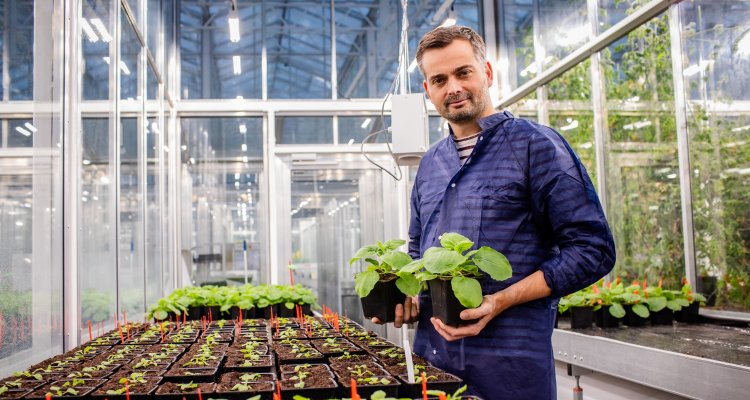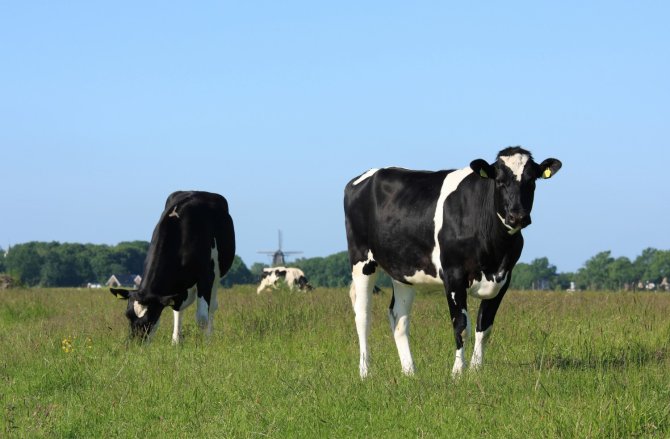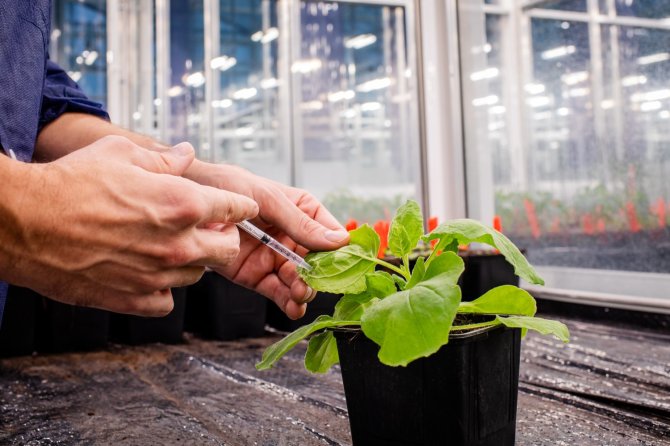Wageningen, The Netherlands
November 28, 2023

Mimicking sugar structures in plants plays a crucial role in the development of effective vaccines against the stomach worm Ostertagia ostertagi. This has been demonstrated by Ruud Wilbers of Wageningen University & Research (WUR) together with researchers from Ghent University and Leiden University Medical Center with a proof-of-concept study. This shows that a vaccine produced in a plant actually protects cows against the parasite. The insights have been published in an article in Scientific Reports and will provide a springboard for the faster and more sustainable development of vaccines against parasites.
Stomach worm infection is a common condition in cows. Infection can lead to lower milk and meat production and even to illness if the worms burden is high. For that reason, infected cows are treated with deworming agents. But this is creating new problems, according to researcher Ruud Wilbers. “Overuse of these drugs, such as administering too often and at the wrong dose, is causing the parasite to develop resistance to the drugs. In the Western world in particular, where a lot of livestock farming is intensive, resistance is a growing problem.”
Deworming not a sustainable solution
What’s more, Wilbers continues, deworming does not offer a sustainable solution. “It just ensures that the parasite is removed from the animal. But the following year, the infection can return if the cow ingests an egg by eating grass. Since infected cows spread eggs with every bowel movement, pastures remain contaminated, keeping the parasite viable for a long time. Another problem with dewormers is that we don’t know exactly what they do. They may also end up in meat and milk and spread to the environment and soil.”
 Infected cows spread eggs with every bowel movement.
Infected cows spread eggs with every bowel movement.
Current vaccine production undesirable
A much more effective and sustainable approach is to vaccinate cows against the parasite. There are currently three available vaccines against parasitic worms, according to Wilbers. “The only problem is that, for the production of these vaccines, you have no alternative but to infect animals. Antigens are isolated from living parasites. This method is undesirable, primarily because you then have to infect healthy animals. It is also unsustainable if you want to develop vaccines on a large scale. This is because you would need an awful lot of infected cows to get enough vaccine.”
Production using other organisms does not work
An alternative production method uses a recombinant expression system. This involves inserting the genetic code from the DNA for an antigen of the parasite into another organism, such as a yeast or bacterium. Wilbers: “This process produces the antigen needed to develop the vaccines. The only problem with this method is that it does not work for stomach worms. Researchers from Ghent University spent a decade trying to identify the right antigen. But they found out that this no longer works if you make it in a yeast. This is because other organisms cannot reconstruct the natural sugar structures (glycans) of the parasite.”
Collaboration with Ghent University
At a conference in Greece, Wilbers came into contact with the Ghent researchers and learnt of the problem they were facing. “I was there for a presentation on making worm proteins in our plant expression system. We teamed up and started researching how to mimic the parasite’s protein in plants. Initially, together with LUMC, we looked at the sugar composition of the parasite and how similar it is to that of plants. In stomach worms, the glycans are not very complex compared to other worm parasites. We worked out what sugar residues are on them and what enzymes are needed to make them.”
 Development of effective vaccine against stomach worms using plants (Photo: Joris Aben Fotografie)
Development of effective vaccine against stomach worms using plants (Photo: Joris Aben Fotografie)
Modification of sugar structure in plant
The major advantage of a plant over other expression systems is that a plant has very few enzymes to manipulate sugars, says Wilbers. “This makes it easy to remove existing sugar structures and to start from a ‘naked’ structure. From here you build a new structure, so to speak, by placing sugar cubes on top of it with the chosen enzymes. It’s a bit like Lego for experts. Plants also tolerate this modification. We then allow the enzymes for the new structure to be expressed in the plant together with the antigen.”
Proof-of-concept study shows vaccine effectiveness
With a proof-of-concept study, the researchers have shown that the sugar composition is indeed crucial to the vaccine’s effectiveness. “This discovery is the central focus of the article in Scientific Reports. Previous research suggested this, but conclusive evidence was lacking. This discovery will provide a springboard for vaccines for other parasites in livestock, such as liver fluke, as well as human parasites. We will now conduct several projects to explore the potential further. It is expected that mimicking sugar structures in plants will accelerate the development of vaccines against worm parasites.”
Separating sugars from the protein
In the future, Wilbers hopes to be able to separate the sugars from the protein altogether. “With some parasites, you can see that the immune response that offers protection is focused on sugars. If you can separate sugar elements from the protein, that could make vaccine production even easier. This would mean that you only have to look at the parasite’s sugar composition. If we manage to vaccinate with sugar structures, we can develop vaccines even faster. After all, in that case, you don’t have to identify individual antigens anymore.”
Effectief vaccin tegen koeienparasiet dankzij aanpassingsuikerstructuren in plant
Het nabootsen van suikerstructuren in planten speelt een cruciale rol bij de ontwikkeling van effectieve vaccins tegen de maagworm Ostertagia ostertagi. Dit heeft Ruud Wilbers van Wageningen University & Research (WUR) samen met onderzoekers van de Universiteit Gent en het Leids Universitair Medisch Centrum aangetoond met een proof-of-concept studie. Hieruit blijkt dat een in een plant geproduceerd vaccin koeien ook daadwerkelijk bescherming biedt tegen de parasiet. De inzichten zijn gepubliceerd in een artikel in Scientific Reports en vormen een springplank naar de snellere en duurzamere ontwikkeling van vaccins tegen parasieten.
Maagworminfectie is een veel voorkomende aandoening bij koeien. Een infectie kan leiden tot een lagere melk- en vleesproductie en bij een hoge wormlast zelfs tot ziekte. Daarom worden geïnfecteerde koeien behandeld met ontwormingsmiddelen. Maar dit levert volgens onderzoeker Ruud Wilbers weer nieuwe problemen op. “Door overmatig gebruik van deze middelen, zoals te vaak en in een onjuiste dosis, ontwikkelt de parasiet resistentie. Zeker in de westerse wereld, met veel intensieve veeteelt, is resistentie een steeds groter probleem.”
Ontwormen geen duurzame oplossing
Bovendien, zo vervolgt Wilbers, biedt ontwormen geen duurzame oplossing. “Het zorgt er alleen maar voor dat de parasiet uit het dier wordt verwijderd. Maar het jaar erop kan de infectie weer terugkomen als de koe een eitje binnenkrijgt via het eten van gras. Doordat besmette koeien met elke ontlasting eitjes verspreiden, blijven weides langdurig besmet. Zo blijft de parasiet lang levensvatbaar. Ander probleem van ontwormingsmiddelen is dat we niet weten wat ze precies doen. Het kan zijn dat ze ook in vlees en melk belanden en dat ze zich verspreiden naar de omgeving en bodem.”
Huidige vaccinproductie onwenselijk
Veel effectiever en duurzamer is het om koeien te vaccineren tegen de parasiet. Momenteel zijn er volgens Wilbers drie vaccins op de markt tegen parasitaire wormen. “Het probleem is alleen dat je voor de productie van deze vaccins afhankelijk bent van het infecteren van dieren. Hierbij worden antigenen uit levende parasieten geïsoleerd. Deze methode is onwenselijk. Ten eerste omdat je dan gezonde dieren moet gaan infecteren. Daarnaast is het onhoudbaar wanneer je op grote schaal vaccins wilt ontwikkelen. Je hebt dan namelijk ontzettend veel geïnfecteerde koeien nodig om aan voldoende vaccin te komen.”
Productie via andere organismen lukt niet
Een alternatieve productiemethode is via een recombinant expressiesysteem. Hierbij wordt de genetische code uit het DNA voor een antigen van de parasiet in een ander organisme geplaatst, zoals een gist of bacterie. Wilbers: “Die produceert dan het antigen waarmee je de vaccins kunt ontwikkelen. Het probleem van deze methode is alleen dat deze niet werkt voor maagwormen. Onderzoekers van Universiteit Gent zijn tien jaar lang bezig geweest om het juiste antigen te identificeren. Maar ze kwamen erachter dat deze niet meer werkt als je ‘m in een gist maakt. Dat komt omdat andere organismen de natuurlijke suikerstructuren (glycanen) van de parasiet niet kunnen reconstrueren.”
Samenwerking met Universiteit van Gent
Op een congres in Griekenland kwam Wilbers in contact met de Gentse onderzoekers en het probleem waar ze tegenaan liepen. “Zelf was ik daar voor een presentatie over het maken van wormeiwitten in ons plantenexpressiesysteem. We hebben de handen ineen geslagen en zijn gaan onderzoeken hoe we het eiwit van de parasiet in planten kunnen namaken. In eerste instantie hebben we samen met het LUMC gekeken hoe de suikercompositie van de parasiet eruit ziet en hoe vergelijkbaar die is met die van planten. Bij maagwormen zijn de glycanen niet heel complex vergeleken met andere wormparasieten. We hebben achterhaald welke suikerresiduen erop zitten en welke enzymen nodig zijn om die überhaupt te maken.”
Aanpassing suikerstructuur in plant
Het grote voordeel van een plant ten opzichte van andere expressiesystemen is dat een plant maar weinig enzymen heeft om suikers te manipuleren, zegt Wilbers. “Hierdoor is het eenvoudig bestaande suikerstructuren te verwijderen en te beginnen vanuit een ‘naakte’ structuur. Van hieruit bouw je als het ware een nieuwe structuur op door suikerblokjes erop te zetten met gekozen enzymen. Een soort lego voor gevorderden. Planten tolereren deze aanpassing ook. De enzymen voor de nieuwe structuur brengen we dan samen met het antigen tot expressie in de plant.”
Proof-of-concept-studie toont effectiviteit vaccins
Met een proof-of-concept-studie hebben de onderzoekers aangetoond dat de suikercompositie inderdaad cruciaal blijkt voor de effectiviteit van het vaccin. “Deze bevinding staat centraal in het artikel in Scientific Reports. Eerder onderzoek hintte hier al op, maar bewijs ontbrak nog. De ontdekking vormt een springplank voor vaccins voor andere parasieten bij vee, zoals de leverbot, maar ook humane parasieten. In verschillende projecten gaan we de potentie nu verder onderzoeken. De verwachting is dat het nabootsen van suikerstructuren in planten de ontwikkeling van vaccins tegen wormparasieten zal versnellen.”
Suikers loskoppelen van het eiwit
In de toekomst hoopt Wilbers de suikers helemaal los te kunnen koppelen van het eiwit. “Bij sommige parasieten zie je dat de afweerreactie die bescherming biedt vaak gericht is op suikers. Als je suikerelementen kunt loskoppelen van het eiwit zou dat de productie van een vaccin nog eenvoudiger kunnen maken. Want dan hoef je bij de parasiet alleen nog maar te kijken naar de suikercompositie. Als we het voor elkaar krijgen om met suikerstructuren te vaccineren, kunnen we nog sneller vaccins ontwikkelen. Je hoeft dan namelijk niet meer individuele antigenen te identificeren.”